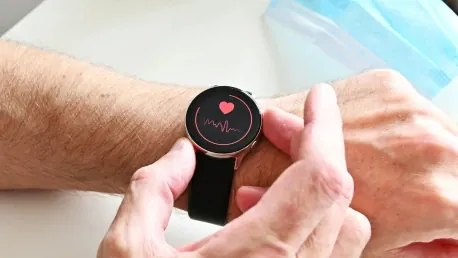Heart Rate Variability (HRV) has emerged as a pivotal metric in the fitness world, providing critical insights into physical readiness and overall health. With the surge in popularity of smartwatches and other wearables, accessing and analyzing HRV data has become more accessible than ever before. This technological leap allows both athletes and casual fitness enthusiasts to fine-tune their fitness routines based on objective physiological data.
Understanding HRV and its Importance
HRV measures the variation in time between each heartbeat, serving as a reflection of the balance between the sympathetic and parasympathetic nervous systems. A higher HRV indicates a well-balanced autonomic nervous system, capable of managing stress effectively and promoting efficient recovery. This balance is crucial for overall health, as it suggests a harmonious interaction between the bodily systems responsible for stress responses and relaxation.
Research demonstrates that monitoring HRV provides valuable insights into one’s readiness for exercise and ability to cope with varying levels of physical stress. This information allows individuals to tailor their workouts according to their physiological state, thus optimizing performance and reducing the risk of injuries due to overtraining. By leveraging HRV data, fitness routines can be adjusted dynamically to ensure they align with an individual’s current physical condition.
The Role of Wearables in HRV Tracking
The rise of wearable technology has revolutionized the way health metrics, including HRV, are tracked and analyzed. Wearable devices from brands such as WHOOP, which continuously gather HRV data, provide users with actionable and personalized insights. These wearables track HRV continuously, delivering real-time data that helps users make informed decisions about their daily activities and exercise levels.
For both elite athletes and fitness enthusiasts, this real-time HRV data is invaluable. It guides them on when to push their limits and when to prioritize recovery. Whether it’s deciding to tackle a high-intensity workout or opting for a rest day, the information gleaned from wearables plays a crucial role in maintaining balance and optimizing training outcomes. These insights help in crafting a fitness plan that accommodates the body’s fluctuating readiness levels.
How to Interpret HRV Data
Understanding HRV data requires a focus on one’s personal baseline rather than comparing oneself to others. HRV naturally declines with age, and it has been observed that women generally have lower HRV scores than men. By establishing a personal baseline, individuals can track their HRV over time and make sense of the fluctuations in a meaningful way.
HRV metrics can vary from day to day due to a variety of factors, such as sleep quality, stress levels, and lifestyle choices. For instance, a higher HRV reading in the morning typically indicates readiness for physical activity, suggesting that the individual can handle more strenuous exercises. Conversely, a lower HRV may indicate the need for lighter activities to foster recovery. This day-to-day tracking allows for a highly tailored approach to fitness.
Practical Applications of HRV in Training
HRV is particularly effective in personalizing training regimens by dictating the intensity of daily workouts. A high HRV is a green light for intense exercises, while a low HRV suggests a need for low-impact activities such as light stretching or meditation. This adaptive training approach not only optimizes performance but also mitigates the risk of injuries by ensuring that the body is fully recovered and ready for physical exertion.
Evidence supports the efficacy of tailoring workout routines based on HRV. Such an approach has been shown to enhance performance outcomes by aligning exercise intensity with the body’s current capabilities. This method of adaptive training helps in maintaining a balanced workload, thereby promoting sustainable progress and reducing the likelihood of overtraining.
Factors Affecting HRV
Several factors can significantly influence HRV scores. Data from WHOOP in 2024 highlights that adequate sleep, moderate caffeine consumption, and consistency in wake-up times positively affect HRV levels. On the other hand, factors such as alcohol intake, illness, and heightened stress levels are linked to decreased HRV. Recognizing the impact of these factors provides individuals with the opportunity to make lifestyle adjustments to enhance their HRV.
For instance, many individuals observe a notable drop in HRV following alcohol consumption, which often leads to reduced intake once the connection between HRV and performance is established. By understanding these influences, users can employ strategies to improve their HRV, such as prioritizing sleep, managing stress, and making healthier lifestyle choices, ultimately contributing to better overall health and fitness.
HRV and Recovery
HRV serves as a powerful indicator of recovery. Regular monitoring of HRV can reveal trends that indicate whether an individual is recovering adequately from physical exertion and life stresses. A consistently low HRV may suggest the need for a temporary reduction in training intensity to allow the body to recuperate. This proactive adjustment helps prevent overtraining and associated health risks.
On the other hand, improvements in HRV signal enhanced fitness and readiness for more demanding activities. For those starting new exercise routines, an initial drop in HRV is normal, but it should gradually increase as the body adapts and becomes fitter. Monitoring these trends in HRV provides crucial feedback that informs adjustments in training intensity, promoting a balanced approach to fitness that safeguards long-term health.
Implementing HRV Data into Fitness Routines
Incorporating HRV data into fitness routines involves more than just adjusting the levels of physical activity. It also encompasses adopting healthier lifestyle practices that positively influence HRV. Ensuring adequate rest, managing stress effectively, and maintaining a balanced diet are all crucial for enhancing HRV scores. Utilizing the insights provided by HRV data helps individuals create a more balanced and effective fitness routine that meets their body’s needs.
The thoughtful integration of HRV insights into daily life can significantly improve physical performance and overall wellness. By being responsive to HRV readings, users can optimize their exercise routines and make informed decisions that promote health and fitness. This holistic approach ensures that fitness activities are aligned with the body’s current state, leading to sustained improvements in health.
The Future of HRV and Wearables
Heart Rate Variability (HRV) has become a crucial metric in the fitness world, offering valuable insights into an individual’s physical readiness and overall well-being. This measure of the variations in time between each heartbeat serves as an indicator of cardiovascular health and the balance of the autonomic nervous system. With the rise in the popularity of smartwatches and fitness trackers, monitoring and analyzing HRV data has become easier and more widespread than ever. This technological advancement allows athletes and even casual fitness enthusiasts to tailor their exercise routines based on concrete physiological data, rather than relying on subjective feelings alone. By keeping an eye on their HRV, individuals can adapt their workouts to align with their body’s current state, optimizing performance and reducing the risk of overtraining. The ability to track HRV continuously provides a personalized approach to fitness and health, making it a valuable tool for anyone looking to enhance their physical condition and overall wellness.









